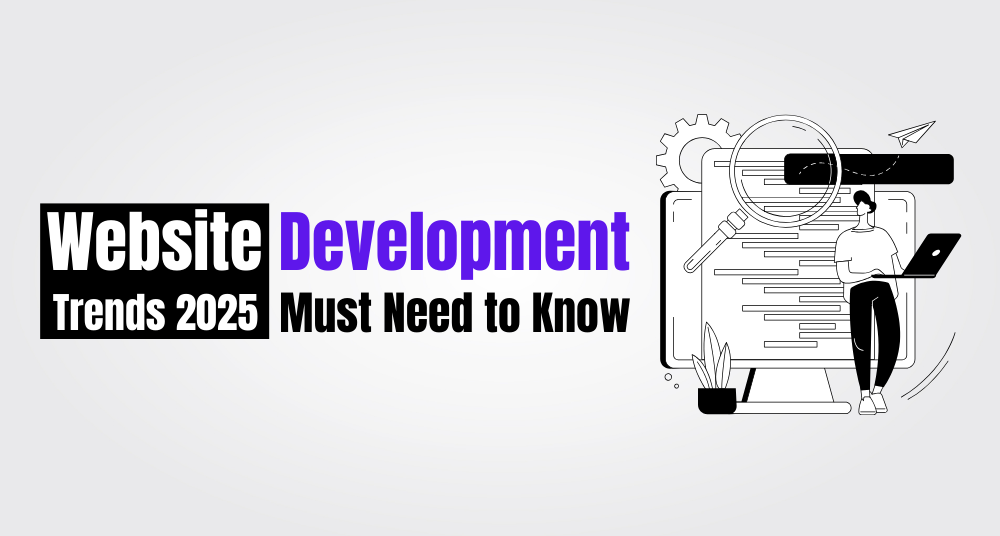Website development is continuously evolving as new technologies, design philosophies, and user preferences shape the digital landscape. As we approach 2025, staying ahead of the curve with the latest website development trends can be a game-changer for businesses. Whether you’re developing a corporate site, an e-commerce platform, or a personal blog, keeping up with these trends can improve user engagement, enhance functionality, and boost your SEO rankings.
In this blog, we’ll explore the top 16 website development trends that are expected to dominate in 2025, and how you can incorporate them into your development strategy.
AI-Powered Websites
Artificial Intelligence (AI) continues to make its mark on web development. AI-powered tools and features can greatly enhance the user experience, automate repetitive tasks, and improve content personalization. In 2025, expect to see more websites integrating AI for:
Personalized Content: AI-driven content recommendations, tailored to user preferences based on their browsing history, engagement, and behavior.
Chatbots: AI chatbots providing immediate customer support, answering frequently asked questions, and even processing basic transactions.
Automated Design: AI tools that assist in web design by suggesting layouts, color schemes, and typography based on the site’s purpose and target audience.
Incorporating AI can significantly streamline user interactions, making your website more intuitive, responsive, and customer-centric.
Voice Search Optimization
With the rise of smart speakers and voice assistants like Amazon’s Alexa, Google Assistant, and Apple’s Siri, voice search is expected to see massive growth in 2025. Websites that are optimized for voice search will have a competitive advantage, as users are increasingly searching for information through spoken commands.
To optimize for voice search:
- Use natural language and conversational keywords in your content.
- Structure your content to answer common questions directly.
- Focus on local SEO since many voice searches are location-based.
Voice search optimization isn’t just about adding keywords; it’s about making your content accessible in the way users are naturally searching for it.
Mobile-First and Responsive Design
Mobile-first design isn’t just a trend; it’s a necessity. With the majority of internet traffic coming from mobile devices, websites must be designed and developed with mobile users in mind first, before scaling up to desktop. In 2025, a mobile-first approach will dominate web development to ensure a seamless, user-friendly experience across all devices.
Responsive design ensures that your website adapts to the screen size of any device, providing a smooth experience for users on smartphones, tablets, or desktops. Google’s mobile-first indexing means that your website’s mobile version will directly impact your search rankings, making this trend crucial for SEO.
Progressive Web Apps (PWAs)
Progressive Web Apps (PWAs) are websites that function like apps. They combine the best of both worlds: the broad reach of the web and the speed, functionality, and user experience of mobile apps. PWAs load quickly, work offline, and provide push notifications, making them ideal for improving engagement and retention.
In 2025, PWAs are expected to continue rising in popularity because of their ability to provide a native app-like experience without the need for downloading from app stores. PWAs are also SEO-friendly, providing the benefits of web-based content while offering app-like features.
Dark Mode
Dark mode has become a widely popular design trend, and it’s expected to continue in 2025. This feature gives users the option to switch to a darker color scheme, which is easier on the eyes, especially in low-light environments. Additionally, dark mode can improve battery life on OLED screens, making it an appealing option for mobile users.
From a development perspective, incorporating dark mode into your website is easy with CSS media queries. Offering this option can enhance user experience, increase engagement, and keep your website trendy and up-to-date.
Minimalistic and Clean Design
In 2025, website design will continue to shift toward simplicity and clarity. Minimalism in web design focuses on reducing clutter, using whitespace effectively, and emphasizing essential content. Users now expect streamlined, straightforward experiences that focus on what’s most important.
A minimalistic design isn’t just about aesthetics; it’s also about performance. Clean, simple layouts often load faster, improving website speed—a key factor in user satisfaction and SEO rankings.
Key features of minimalist design include:
- Clear typography and color schemes.
- Emphasis on visual hierarchy.
- Simple navigation and intuitive layout.
This trend is all about enhancing usability while creating a visually appealing experience.
Augmented Reality (AR) Integration
Augmented Reality (AR) is no longer a futuristic concept; it’s becoming a key feature of modern web development. In 2025, more websites will integrate AR to provide interactive and immersive experiences for users.
For example, in e-commerce, AR allows users to visualize products in their environment, such as trying on clothes virtually or seeing how furniture fits in their home. AR enhances user engagement and can drive conversions by providing interactive product demos and experiences.
Web 3.0 and Blockchain Integration
The emergence of Web 3.0 and blockchain technology is poised to transform how websites interact with users. Web 3.0 promises a decentralized, more secure, and user-centric internet, while blockchain provides transparency and security for transactions.
In 2025, blockchain will likely become more integrated into websites, especially in industries such as finance, healthcare, and supply chain management. Features like cryptocurrency payments, smart contracts, and NFTs are expected to see more widespread use, providing users with a more secure and transparent online experience.
API-First Development
API-first development involves creating applications with APIs as the primary method of communication between different services and systems. This trend will continue to rise in 2025, as more businesses focus on scalability and flexibility in their websites and web applications.
With API-first development, you can:
- Integrate multiple services and platforms seamlessly.
- Allow for easier updates and changes.
- Improve website performance by optimizing backend processes.
- API-first development allows companies to stay agile and quickly adapt to new technologies and trends.
Motion UI and Animation
Motion UI is the use of animations to enhance user interaction and guide visitors through the website. In 2025, web developers will use animations more creatively to make websites feel more interactive and dynamic.
Animations can be used for:
- Page transitions to keep users engaged.
- Scrolling effects that add depth and dimension to a website.
- Micro-interactions that respond to user actions, like hovering over buttons or filling out forms.
- When done right, motion UI can enhance the overall user experience, making websites feel more engaging and modern.
No-code/Low-code Development
No-code and low-code platforms are transforming the way websites are built, making development faster, more accessible, and more cost-effective. These platforms allow individuals with little to no coding experience to create complex websites through drag-and-drop interfaces, templates, and pre-built components.
In coming years, no-code/low-code platforms will continue to grow in popularity, enabling businesses to create and maintain websites with greater efficiency. These platforms empower teams to rapidly prototype and deploy sites, offering flexibility without needing specialized technical knowledge.
Serverless Architecture
Serverless architecture removes the need for developers to manage servers, as the cloud provider handles all the infrastructure. This approach allows for more efficient scaling, cost savings, and faster development cycles.
In next 10 years, serverless architecture will continue to gain traction as websites and applications become increasingly dynamic. By leveraging serverless solutions, businesses can scale quickly, reduce operational complexity, and improve the speed and reliability of their websites.
Cloud Computing
Cloud computing allows businesses to store, manage, and process data in a secure and scalable environment. In 2025, cloud-based solutions will remain at the forefront of website development, offering improved accessibility, faster load times, and enhanced security.
By utilizing cloud platforms like AWS, Google Cloud, or Microsoft Azure, businesses can ensure that their websites are reliable, scalable, and equipped to handle traffic spikes without performance issues.
Jamstack
Jamstack (JavaScript, APIs, and Markup) is an architecture that decouples the frontend and backend of a website, allowing for faster load times, better security, and easier scalability. Websites built with This modern architecture focus on delivering pre-rendered static pages, while dynamic content is pulled in via APIs.
Jamstack will continue to rise in popularity, as it allows businesses to build fast, secure websites while improving the developer experience. Its benefits also include lower hosting costs and improved SEO.
Headless CMSs
A headless CMS (Content Management System) allows developers to deliver content to multiple platforms—websites, mobile apps, IoT devices, and more—through APIs, decoupling the frontend from the backend. In 2025, headless CMSs will continue to thrive, offering businesses greater flexibility and control over how content is delivered.
The flexibility of headless CMS allows for easy integration with various frontend frameworks like React, Vue.js, and Angular, providing a smooth development process and delivering consistent content across channels.
Internet of Things (IoT)
As IoT devices become more integrated into our daily lives, websites will need to adapt to interact with a growing number of smart devices. In 2025, websites that integrate IoT will offer enhanced user experiences, such as smart home controls, connected product experiences, and personalized services.
IoT integration allows websites to collect data from connected devices, providing valuable insights and enabling more personalized interactions with users.
Related Blog: Top Backend Technologies for Web Development
Conclusion
The future of website development looks exciting and filled with opportunities to create highly interactive, secure, and user-friendly websites. AI, mobile-first design, PWAs, and AR are just a few of the recent website development trends shaping the industry. The rise of no-code/low-code platforms, serverless architecture, cloud computing, Jamstack, headless CMSs, and IoT will continue to empower businesses to build innovative, scalable websites.
By staying updated with these trends and incorporating them into your website development strategy, you can ensure that your website remains competitive, engaging, and future-ready. Remember, the key to success is not just following trends but understanding how they can improve user experience, increase engagement, and help you meet your business objectives. Stay ahead of the curve, and your website will thrive in the ever-evolving digital world.






What do you think?
It is nice to know your opinion. Leave a comment.